How to Prevent and Manage Pain in Operating: Professional Tips and Recommendations
As runners, we often discover ourselves captured between the euphoria of pushing our physical limits and the discomfort that can accompany it. The search of that runner's high can in some cases be prevented by the undesirable friend of discomfort. Whether you are a skilled marathoner or a beginner striking the sidewalk for the initial time, the bothersome existence of discomfort and discomfort is an usual . Nevertheless, there exist proven methods and expert guidance that can help minimize and take care of these pains, enabling you to concentrate on the joy of running itself.
Relevance of Proper Footwear
Proper shoes plays an important role in stopping and managing discomfort for joggers, as it substantially influences their convenience, efficiency, and general foot health. When it concerns running, using the right shoes can make all the distinction. Uncomfortable or incorrect shoes can result in a host of issues such as sores, shin splints, plantar fasciitis, and much more severe injuries like stress and anxiety fractures.
Picking the right running shoes involves thinking about factors such as foot type, gait technicians, running surface, and individual choices. Joggers with high arcs might need more cushioning and assistance, while those with flat feet might gain from stability footwear. Additionally, comprehending pronation (the inward rolling of the foot) and supination (the exterior rolling of the foot) can help in selecting shoes that give the appropriate level of arch assistance.
Purchasing quality operating shoes that are appropriate for your private requirements can aid prevent pain and pain while enhancing your running experience. Focusing on proper footwear is not simply about efficiency but also concerning guarding your foot health in the future.

Reliable Warm-up Techniques
Shoes option is just one facet of getting ready for an effective run; another crucial component is implementing efficient warm-up techniques to maximize efficiency and decrease the risk of injury. A vibrant workout routine prior to a run assists boost blood flow to the muscular tissues, enhances flexibility, and enhances the array of movement of the joints. Dynamic stretches like leg swings, high knees, and hip circles are advantageous in preparing the body for the physical needs of running. Progressively boosting the strength of the warm-up workouts can assist activate the muscles and enhance neuromuscular coordination.
Along with dynamic stretches, integrating some light cardio exercises such as running or missing rope can further raise the heart price and warm up the body. This mix of dynamic stretching and light cardio aids loosen tight muscular tissues, lubricate the joints, and emotionally prepares the runner for the upcoming exercise (running workout). By making warm-ups a regular part of your running regimen, you can considerably lower the danger of injuries and do at your best throughout each run
Trick Stretching Exercises
When planning for a run, incorporating crucial extending exercises is necessary to enhance muscle mass adaptability and prevent injuries - Read More. Dynamic stretches such as leg swings, high knees, and hip circles are valuable for heating up the muscular tissues and boosting range of movement prior to a run. These movements assist boost blood flow, loosen limited muscular tissues, and prepare the body for the activity in advance
Fixed stretches like calf stretches, hamstring stretches, and quadriceps stretches must adhere to a run to help in muscular tissue recovery and stop rigidity. Holding each stretch for 15-30 seconds allows the muscles to relax and lengthen, decreasing the threat of post-run discomfort and possible injuries.
Additionally, incorporating yoga postures like downward pet, pigeon position, and spinal twists can target numerous muscle mass teams at the same time, advertising general adaptability and toughness. Regular stretching routines not only enhance efficiency but additionally aid in preserving excellent running type and stopping overuse injuries. Keep in mind, correct stretching methods are vital for a safe and pleasurable running experience.
Recuperation and Relax Approaches
After finishing a run, carrying out efficient recovery and remainder strategies is necessary for optimizing performance and decreasing the danger of injuries. Additionally, including rest days right into your training routine is vital to protect against overuse injuries and exhaustion.
Energetic recuperation techniques such as mild extending, foam rolling, and yoga can assist boost circulation, lower muscle discomfort, and improve adaptability. It is also helpful to focus on hydration and nourishment post-run to restore electrolytes, glycogen stores, and promote muscle mass recovery.
Cross-training activities like swimming or cycling can supply a break from the recurring impact of running while still keeping cardiovascular health and fitness - running strategy. Listening to your body and acknowledging when it requires a break is crucial to avoid persistent injuries and making certain lasting running success. Remember, remainder is not a sign of weak point yet a critical element of an all-round training routine
Cross-Training Benefits

It permits you to function on various elements of health and fitness that might not be targeted only with running, leading to a more well balanced and versatile professional athlete. Furthermore, cross-training can assist improve running performance by addressing muscular inequalities and weaknesses that may impede performance.
Conclusion
To conclude, correct footwear, workout methods, stretching exercises, recuperation techniques, and cross-training are important parts in protecting against and managing discomfort in running. By including these techniques right into your routine, you can reduce the threat of injury and pain while making the most of performance and satisfaction of the sport. Read More. Remember to listen to your body, focus on remainder and healing, and look for expert advice when required to make sure a safe and efficient running experience